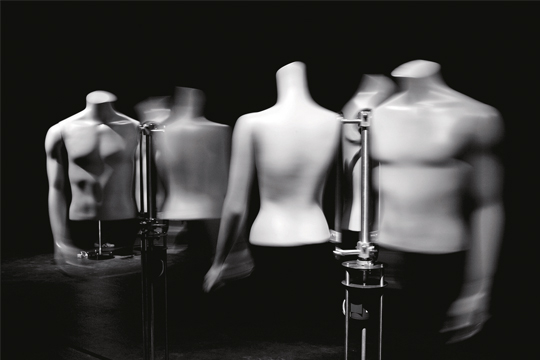LIU HAN-CHIH: WALKING IN PLACE
| December 19, 2013 | Post In LEAP 23

On first encountering the works of Taiwanese artist Liu Han-Chih, few people fail to be amused by the sense of black humor around them. One, titled Collar Seizing Device, is a mechanical installation which sports a handle that connects directly to the viewer’s collar. When the handle is turned, the viewer is dragged upwards by the collar—a convenient tool for bullying, or an absurd way of offering a taste of one’s own medicine. However, the work also brings to light the presumptuousness between human consciousness and external objects. It was this work, along with others in the same series, that won Liu the grand prize of the 2011 Taipei Arts Awards.
Two years on, Liu Han-Chih presents a series of five new works, titled “Walking in Place.” The series draws on his past proclivity for mechanical installations accompanied by explanatory drawings. In this way, what first appears like bizarre, inexplicable stage props suddenly becomes concrete objects with actual meaning. While observers are able to intuitively comprehend the function of these devices through the drawings and notes, they are simultaneously unwittingly drawn into the various traps laid out by the artist.
These traps are responsible for the slight air of mockery surrounding Liu Han-Chih’s works, which extract and examine the otherwise unnoticed details of daily life. Walking Machine of Heartlessness consists of two sets of three mannequins placed side-by-side, and rotating in opposite directions. In the narrow space between, a small treadmill is fitted: stepping onto it, the viewer must not only begin walking quickly, she must also constantly be on guard against the relentless attack of the mannequins on either side. The feeling is that of being stuck on a crowded street, unable to move either left or right. According to Liu: “In the big city, the individual and the crowd often have a melancholic relationship: the individual has no way to integrate into the crowd, and also no way to escape from it.” No matter if taken as a comical or simply awkward act, only those who know this feeling may fully understand the work.
Liu Han-Chih’s works present various striking insights into failure, though not of the Sisyphean kind. With Liu, failure is more knowing and defeatist, it is failure dealt with openly. Look at the Necktie is an instrument which, when put on, forces a person’s head downwards, allowing him or her to avoid eye contact with others. However, the bowed head is also fawning and desperate, submissive and defeated. Or, perhaps, this is simply an act of passive resistance against mainstream society. Liu’s works display such outsider tendencies, employing neurotic humor to question the blind pursuit of absurd values. Unable to speak themselves, his works use other methods to arouse the darkness in our hearts.
Compared to 2011’s work, “Walking in Place” uses language more incisively: the title of Blooming in a Railway Carriage alludes to the lotus flower, in reality describing a strange instrument featuring wriggling prosthetic hands which are used to alarm and annoy fellow passengers in a packed train carriage. These prying hands cannot be blamed for their actions; they know not what they are doing. Irritating as they are, the whole thing could be taken as little more than a harmless joke. Elsewhere, Visitor is an astonishing work that may leave some speechless, in the way it so accurately describes the panic and anxiety felt by us all. The “visitor” rings the doorbell; the person inside is convinced of the danger outside, hypnotized by it. An accompanying text reads: “I know you haven’t really been hypnotized. You’re only pretending, so that just one day in your hollow life seems special.”
At first glance, Liu Han-Chih’s works may simply make their audience burst out laughing. But upon closer inspection, they reveal to them the more callous side of society. This artist doesn’t tackle grand philosophical topics. His is a pursuit of the truth hiding beneath reality, a hint at a crisis yet to break out. His art does not explain, but is made so that the burdens which we all carry around with us can be laughed at, and cast off.

